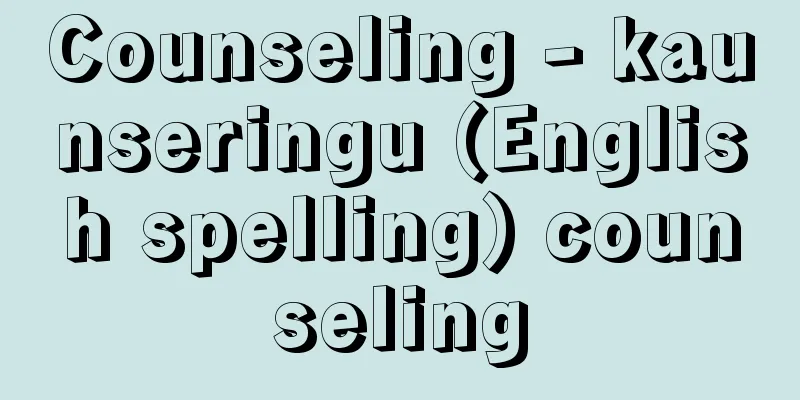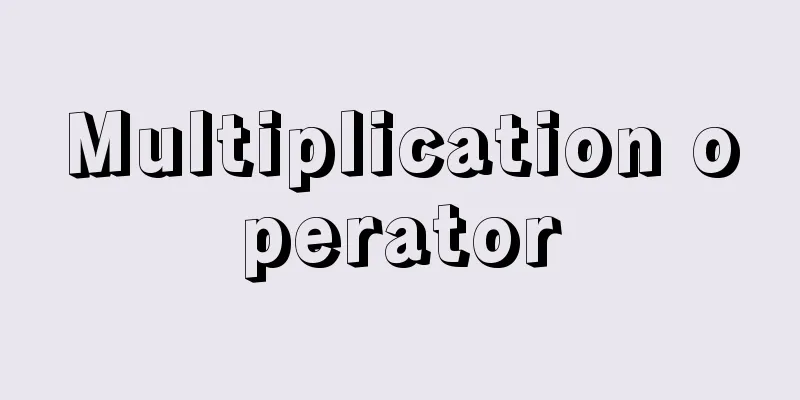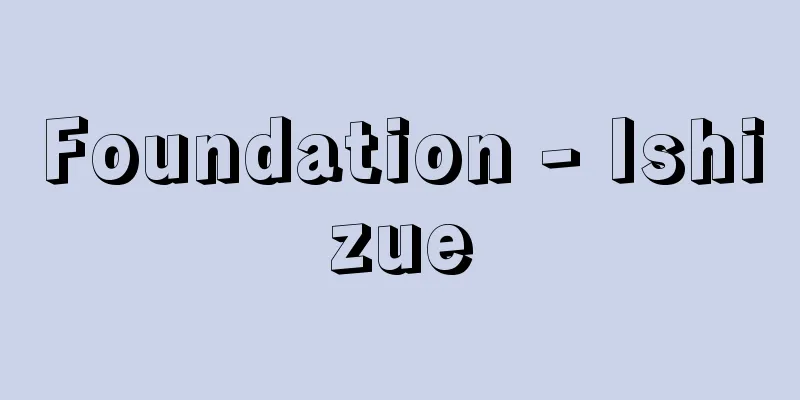Counseling - kaunseringu (English spelling) counseling

|
It is a general term for interpersonal activities that offer psychological assistance and support from a professional perspective to individuals (clients, sometimes called clients) who are suffering from various psychological problems and anxieties and are seeking to resolve or eliminate these problems. [Minoru Masuda] Counselling and psychotherapyPsychological assistance and support for others can be broadly divided into three functions according to the problem: (1) therapeutic, (2) preventive, and (3) developmental. Counseling is an interpersonal assistance and support act that includes these three functions. In contrast, dealing with individuals who have problems based on psychological trauma is done as therapeutic assistance and support, and is called psychotherapy. While counselling and psychotherapy share the common element of providing psychological assistance and support, the specific problems and other characteristics of the latter are particularly emphasized, and it is often seen as being distinct from counselling. [Minoru Masuda] Classification and theoryIn actual counseling, clients have a variety of problems, so the specific response (approach or method of dealing with them) is tailored to the client and is carried out making use of the function. The field of practice includes all aspects of life and living, such as education and childcare, health and welfare, medicine and nursing, industry and management, corrections and justice, and defense (SDF). The theories that guide counseling have been constructed and reconstructed through the exploration and verification of many psychological clinical facts and phenomena, and today, with exploration from various angles, many theories are being used in the practice of psychological assistance and support. Among these, the three most representative theories are as follows: (1) Psychoanalytic counseling: Based on the psychological treatment developed by the psychiatrist Freud, it focuses on the client's free association and aims to release the complexes hidden within the client through an analysis of the client's deep inner self. (2) Behavioral Counseling Also known as behaviorist counseling. It began to be constructed as a counseling theory in the late 1950s, and is based on behavioral and learning theories, aiming to change the behavior of clients. Various responses are devised to solve and eliminate worries, anxieties, fears, etc. from the perspective of individual behavior. (3) Client-centered counseling: Also called person-centered counseling, this was created and advocated by Rogers. It is a form of psychological interpersonal assistance and support that believes in the client's ability to grow and solve problems, and relies on this to help the client realize their true potential. In addition to these, there are many other counseling-related theories that are also practiced, but the following theories can be considered as approaches and methods that are heavily influenced by psychotherapy: (1) Cognitive behavioral therapy: A type of psychological treatment developed by Albert Ellis (1913-2007) and Aaron Temkin Beck (1921-2021) that attempts to repair the discrepancy between cognition and behavior. (2) Autogenic Training: Founded by the German psychiatrist Johannes Heinrich Schultz (1884-1970), this is a training therapy that encourages the patient to eliminate tension throughout the body and regulate their own physical and mental state through concentration, autosuggestion, etc. (3) Art Therapy: Music therapy applies the functional effects that music has on human physiology and psychology; psychotherapy that involves activities such as painting, sculpture, and finger painting; and collage therapy, which has been established as an approach today. (4) Hypnotherapy This is a form of psychological treatment that makes use of the characteristics of hypnosis, including cases where hypnosis is used for its therapeutic effects, and cases where hypnosis is used to enhance the effects of other psychological therapies. (5) Morita Therapy This is a psychotherapy developed by the psychiatrist Masatake Morita (1874-1938) for neurotic patients. It involves accepting symptoms as they are while suggesting what should be done to promote the recovery of the natural healing powers inherent in humans. Group approaches include the following therapies: (1) Family Therapy: A method of intervention to help overcome dysfunction in family relationships and transform them into a functional system. (2) Psychodrama: A group method created by psychologist Moreno, utilizing the psychotherapeutic effects of drama (such as catharsis) and being applied to non-therapeutic purposes such as self-development and education. In addition, the following theories have been applied to psychological help and support practice: (1) Gestalt Therapy: A method proposed by Frederick Salomon Perls (1893-1970) that helps people to embody their true self and holistic existence in which the body and mind are in harmony by deepening awareness of body language (language that emanates from physical sensations, etc.). (2) Reality Therapy: A method proposed by William Glasser (1925-2013) that helps people achieve a balanced satisfaction of the five basic needs of survival, belonging, power, freedom, and enjoyment. (3) Existential Psychotherapy: A method based on existential philosophy and existential psychology proposed by such thinkers as Binswanger, Medard Boss (1903-1990), and Frankl, which helps individuals transform their way of being while aiming for freedom, responsibility, self-identity, and self-realization. All of these theories are derived based on their underlying view of human beings (what kind of beings humans are perceived to be). According to G. W. Allport's argument, these views of human beings can be broadly divided into three: (1) a reactive being, (2) a reactive being in depth, and (3) a being in process of becoming. It can be said that behavioral counseling is derived from (1), psychoanalytic counseling from (2), and client-centered counseling from (3). [Minoru Masuda] Principles and Techniques in PracticeIn counseling practice, it is essential to see the other person (client) as an individual human being, regardless of who they are. In the relationship that is formed with the client, the following three points must be taken into consideration and are expected to be mastered by those providing clinical interpersonal assistance and support (counselors, etc.). (1) Being-for (his/her inner world): This involves being unfettered by the client's external conditions (age, gender, occupation, etc.), focusing on their existence itself and their inner movements, and having an attitude of respecting them as such, without being judgmental as much as possible. (2) Touching the other person's inner world Being-in (his/her inner world) The client's inner flow, that is, thoughts and feelings, are constantly changing and moving, but you must receive and communicate them here and now. This requires active listening. By continuing to do this, empathy and empathic understanding will emerge, leading to a deep mutual connection with the client and the resolution and resolution of the client's problems. (3) Walking with the other person's inner world Being-with (his/her inner world) Various thoughts and emotions, such as negation and positivity, intensity and calm, strength and weakness, arise inside the client, but while maintaining a psychological connection with the client, one must walk with the client while maintaining a moderate distance and not getting caught up in these movements. To do this, the person in charge of interpersonal support (counselor, etc.) must be generous, flexible, and sensitive, and the establishment of such a relationship with the client will lead to that support. The above three roughly correspond to Rogers' three conditions (unconditional positive regard, empathic understanding, and self-concordance), and are thought to form the foundation of counseling practice.It is important to recognize that the development of each counseling theory and the application and utilization of techniques are based on this foundation. [Minoru Masuda] Current situation and issuesThe word "counseling" has never been used as much as it is today. This is probably due to the expectation that counseling can help resolve and eliminate personal and social problems. In order to meet these expectations and to further solidify the role of counseling and psychotherapy, there has been a widespread demand for qualifications in counseling. Although there are still no so-called national qualifications like those for doctors and lawyers, since the latter half of the 1980s, qualifications with a quasi-public character have been rapidly institutionalized. These include "clinical psychologist" from the Japan Clinical Psychologist Certification Board, "certified counselor" from the Japanese Counseling Association, and certified qualifications (such as "industrial counselor") from various organizations and groups such as the Japan Association of Industrial Counselors. Although the ways in which these qualifications are utilized vary, the "clinical psychologist" qualification is most commonly used, particularly as a "school counselor." However, the reality is that counseling is not generally understood or recognized correctly, and there are many misunderstandings. There are also many cases where the term "counseling" is not used appropriately. Furthermore, there are also negative effects from counseling being provided at a low level. In addition to providing proper education about counseling, there will be an even greater need to improve the quality of those qualified to provide counseling. In addition, since there are many problems that cannot be dealt with through counseling alone, one of the challenges will be to determine the limitations of counseling. [Minoru Masuda] "Learning about Counseling" edited by Mizushima Keiichi, Okado Tetsuo, and Tabata Osamu (1978, Yuhikaku)" ▽ "Counseling in Everyday Life" by Nishimitsu Yoshihiro (1984, Yuhikaku)" ▽ "Health Counseling" by Ide Michiko, Masuda Minoru, and Mito Takako (1987, Kyoiku Iji Shimbunsha)" ▽ "Counseling and 'Encounters'" by Hatase Naoko (1991, Sogensha)" ▽ "Counseling" by Saji Morio (1992, NHK Publishing)" ▽ "Health Counseling" edited by Masuda Minoru (1994, Nihon Bunka Kagakusha)" ▽ "Counseling" 4th edition by Ito Hiroshi (1995, Seishin Shobo)" ▽ "Thinking about Counseling, Volumes 1 and 2, by Kawai Hayao (1995, Sogensha)" ▽ "Learning Counseling: Theory, Experience, and Practice" by Saji Morio, Okamura Tatsuya, and Hosaka Toru (1996, University of Tokyo Press)" ▽ "Principles of Counseling" by Kokubu Yasutaka (1996, Seishin Shobo)" ▽ "Psychoanalytic Counseling: The Foundations of Psychoanalysis and Counseling" by Nakanishi Nobuo, Kasai Makiko, and Matsuyama Koichi (1997, Nakanishiya Publishing)" ▽ "A New Dissecting of Counseling" by Kanno Taizo (1998, Nippon Hyoronsha)" ▽ "Encyclopedia of Industrial Counseling, supervised by Uchiyama Kikuo and Nakazawa Jiro, edited by Kameyama Naoyuki et al. (1999, Kawashima Publishing)" ▽ "Counseling Dictionary" by Ujihara Hiroshi, Ogawa Katsuyuki, Kondo Kunio et al. (1999, Minerva Shobo)" ▽ "Talking about Counseling, Volumes 1 and 2" by Kawai Hayao (1999, Kodansha)" ▽ "Person-Centered Approach" edited by Yoshimi Ito, Minoru Masuda, and Kazuhiko Nojima (1999, Nakanishiya Publishing)" ▽ "Easy-to-understand Psychological Counselling - A Consultant for Troubled Minds" by Hiroshi Minami and Yukinori Hayashi (2000, Nihon Jitsugyo Publishing)" ▽ "Rethinking Rogers - Exploring the Origins of Counselling" by Hiroshi Ujihara and Masaharu Murayama (2000, Baifukan Publishing)" ▽ "Counselling Dictionary" by Colin Feltham and Windy Dryden, translated and supervised by the International Counselling Association (2000, Brain Publishing)" ▽ "Person-Centered Counselling" by Dave Mearns and Brian Thorne, translated by Yoshimi Ito (2000, Nakanishiya Publishing)" ▽ "Morita Therapy and the Mind's Natural Healing Power - New Developments in Morita-Style Counselling" by Hajime Masuno (2000, Hakuyosha Publishing)" ▽ "Counseling for Life" edited by Yoshihiko Morotomi (Yuhikaku, 2011) [References] | | | | | | | | | | | | | | | | | | |Source: Shogakukan Encyclopedia Nipponica About Encyclopedia Nipponica Information | Legend |
|
さまざまな心理的な問題や不安などを抱え、その解決・解消を求めようとする個人(クライエントclient。クライアントとよぶ場合もある)に対して、専門的な視点・観点から心理的な援助・支援をすすめる対人行為の総称である。 [増田 實] カウンセリングと心理療法他者への心理的な援助・支援行為は、その問題状況に応じて、〔1〕治療的therapeutic、〔2〕予防的preventive、〔3〕進展的developmentalな働き(機能)に大別されてすすめられるが、カウンセリングは、これら三つの機能を包含した対人的援助・支援行為である。これに対して、心理的外傷(トラウマtrauma)などに基づく問題をもつ個人への対応は、治療的な援助・支援としてなされるので、これを心理療法(精神療法psychotherapy)とよんでいる。 カウンセリングと心理療法は、このように心理的な援助・支援という共有部分をもちながら、後者における問題などの特異性がとくに強調され、カウンセリングと区別してとらえられることが多い。 [増田 實] 分類と理論実際のカウンセリングでは、クライエントの問題などはさまざまであるから、それらに対する具体的な対応(アプローチあるいは対処の仕方)はそのクライエントに即して、その機能を生かしてすすめられる。その実践領域には、教育・保育、厚生・福祉、医療・看護、産業・経営、矯正・司法、防衛(自衛隊)など、生活や生きることのすべてが含められる。 カウンセリングを導く理論は、多くの心理臨床的な事実や事象の探究・検証などを通して構築され、また再構成されて、今日ではさまざまな面からの探索に伴って、多くの理論が心理的援助・支援の実践に生かされている。そのうち代表的な理論は次の三つである。 (1)精神分析的カウンセリング 精神科医フロイトによって構築された心理治療に基礎をおき、クライエントの自由連想を中心にすすめられ、クライエントの内面の深層を分析することを通して、そのなかに潜むコンプレックスを解除しようとする。 (2)行動療法的カウンセリング 行動主義的カウンセリングともよばれる。1950年代後半からカウンセリング理論として構築され始めたが、行動理論と学習理論に立脚し、クライエントの行動の変容が目ざされる。悩みや不安、恐怖などを個人の行動の面から解決・解消するよう、さまざまな対応がくふうされている。 (3)来談者中心的カウンセリング パーソンセンタード・カウンセリングperson-centered counselingともよばれるが、ロジャーズにより創始・提唱され、個人の成長力や問題解決力を信じ、それにゆだねてクライエントの自己実現を図りながらすすめられる心理的対人援助・支援である。 これら以外にもカウンセリングに関連する理論が多く実践されているが、心理療法的色合いの濃いアプローチ・手法として、次のような理論があげられる。 (1)認知行動療法 エリスAlbert Ellis(1913―2007)やベックAaron Temkin Beck(1921―2021)などによる認知と行動の不一致を修復しようとする心理治療法。 (2)自律訓練法 ドイツの精神科医シュルツJohannes Heinrich Schultz(1884―1970)により創始され、注意の集中、自己暗示の練習などにより、全身の緊張を除いて心身の状態を自分で調整できるようにすすめる訓練的治療法。 (3)芸術療法 音楽が人間の生理と心理に及ぼす機能的効果を応用した音楽療法、また、絵画や造形、フィンガー・ペインティングなどを含む作業を行ってすすめる心理療法、あるいは、今日一つのアプローチとして確立されてきたコラージュ療法。 (4)催眠療法 催眠そのものの治療効果をねらって実施する場合と、催眠を利用してほかの心理療法の効果を付加的に高めようとする場合があるが、それらを含めた催眠の特性を利用して行う心理治療。 (5)森田療法 精神医学者森田正馬(まさたけ)(1874―1938)の開発による神経症患者を対象とした精神療法であり、症状をあるがままに受け入れる一方、行うべきことを提示して人間に備わる自然治癒力の回復を促進する心理治療法。 また、集団的なアプローチとして次のような療法などがある。 (1)家族療法 家族関係における機能不全を克服し、それを機能的なシステムに変化するよう介入援助する方法。 (2)サイコドラマ(心理劇) 心理学者のモレノによって創始され、演劇による心理治療効果(カタルシスなど)を利用しながら、自己啓発、教育など治療以外にも適用される集団的方法。 さらに、次のような理論が心理的な援助・支援の実践に適用されている。 (1)ゲシュタルト療法 パールズFrederick Salomon Perls(1893―1970)によって提唱された方法で、身体言語(身体感覚などから発することば)への気づきを深めることなどを通して、身体と心の一致した、その人らしさ、全人的な存在を体得するよう援助する方法。 (2)現実療法 グラッサーWilliam Glasser(1925―2013)により提唱され、生存、所属、力、自由、楽しみの五つの基本的欲求をバランスよく満たすことができるように援助する方法。 (3)実存的心理療法 ビンスワンガー(ビンスバンガー)、ボスMedard Boss(1903―1990)、フランクルなどによる実存哲学や実存心理学に依拠し、自由と責任、自己同一性、自己実現などを目ざしながら、個人のあり方を変容するように援助する方法。 これらの理論は、いずれもその支柱をなす人間観(人間をどのような存在としてとらえるか)に基づいて導き出されているが、G・W・オールポートの所論によれば、これらの人間観は、〔1〕反応する存在a reactive being、〔2〕深層で反応する存在a reactive being in depth、〔3〕生成過程にある存在a being in process of becomingの三つに大別してとらえられるが、行動療法的カウンセリングは〔1〕から、精神分析的カウンセリングは〔2〕から、来談者中心的カウンセリングは〔3〕から導き出されている、といえる。 [増田 實] 実践における原則と技法カウンセリングの実践に際しては、その相手=クライエントがだれであっても、一個の人間a human beingとしてみるということが肝要であるが、そこで形成されるクライエントとの関係では、次の三つが顧慮され、そして、心理臨床的対人援助・支援者(カウンセラーなど)に体得されるよう求められる。 (1)相手の内的世界に向かうことbeing-for(his/her inner world) クライエントの外的諸条件(年齢、性別、職業など)にとらわれず、その存在そのもの、内面の動きに目を向け、できるかぎり評価的にとらえずにそれ自体を尊重するというあり方(態度)をもつ。 (2)相手の内的世界に触れることbeing-in(his/her inner world) クライエントの内面の流れ、すなわち、考えや感情などは、瞬時瞬時に変化しながら動いているが、その時々の「いま、ここで」here and nowのそれらを受け止め、そして、伝えていく。これには「傾聴」が欠かせない。これを続けていくなかで、共感empathyや共感的理解empathic understandingが生じ、クライエントとの相互的な深いつながりやクライエントの問題解決・解消に導かれる。 (3)相手の内的世界とともに歩むことbeing-with(his/her inner world) クライエントの内側では、否定と肯定、激と静、強と弱などさまざまな考えや感情の動きが惹起(じゃっき)するが、クライエントとの心理的なつながりをもちながら、この動きに巻き込まれずに、ほどよい距離を保ってともに歩む。これがなされるには、対人援助・支援者(カウンセラーなど)として器の大きさや柔軟さ、感受性の豊かさなどが問われるが、クライエントとのこのような関係の成立がその援助・支援に結びつく。 以上の三つは、ロジャーズのいう3条件(無条件の積極的関心、共感的理解、自己一致)にほぼ符合するが、これらはカウンセリングの実践においてその土台をなすと考えられ、そして、それぞれのカウンセリング理論の展開、技法の適用や活用は、この土台の上で成り立つ、という認識が望まれる。 [増田 實] 現状と課題カウンセリングということばが今日ほど多く使われることは、これまでなかった。それは、個人的また社会的な問題解決・解消に対するカウンセリングへの期待の表れである、と思われる。 これらの期待にこたえ、また、カウンセリングや心理療法の果たす役割をより確かにするため、カウンセリングに関する資格化が広く求められてきている。そのなかで、医師、弁護士などのような、いわゆる国家資格までにはいまだ至っていないが、1980年代の後半以降、準公的性格を有する資格が急速に制度化されるようになった。日本臨床心理士資格認定協会による「臨床心理士」をはじめ、日本カウンセリング学会の「認定カウンセラー」、日本産業カウンセラー協会などの諸機関・団体による認定資格(「産業カウンセラー」など)がそれである。これらの資格の生かされ方はそれぞれ異なるが、「臨床心理士」の資格は、とくに「スクールカウンセラー」としてもっとも多く活用されている。 しかし、カウンセリングに関して、一般的には誤りのない理解や認識が得られているとはいえない現状であり、誤解も多い。また、カウンセリングということばが適切な使われ方をされていない場合も散見する。さらに、低レベルでのカウンセリングがなされていることによる弊害も生じている。 カウンセリングに関する適切な啓蒙(けいもう)とともに、カウンセリング関係有資格者の質の向上が、今後よりいっそう求められる。また、カウンセリングのみでは対応しきれない問題も多いので、その実施に際しての限界を見極めることも課題の一つにあげられよう。 [増田 實] 『水島恵一・岡堂哲雄・田畑治編『カウンセリングを学ぶ』(1978・有斐閣)』▽『西光義敞著『暮らしの中のカウンセリング』(1984・有斐閣)』▽『井出美智子・増田實・見藤隆子著『ヘルス・カウンセリング』(1987・教育医事新聞社)』▽『畠瀬直子著『カウンセリングと「出会い」』(1991・創元社)』▽『佐治守夫著『カウンセリング』(1992・日本放送出版協会)』▽『増田實編著『健康カウンセリング』(1994・日本文化科学社)』▽『伊東博著『カウンセリング』第4版(1995・誠信書房)』▽『河合隼雄著『カウンセリングを考える 上・下』(1995・創元社)』▽『佐治守夫・岡村達也・保坂亨著『カウンセリングを学ぶ――理論・体験・実習』(1996・東京大学出版会)』▽『国分康孝著『カウンセリングの原理』(1996・誠信書房)』▽『中西信男・葛西真記子・松山公一著『精神分析的カウンセリング――精神分析とカウンセリングの基礎』(1997・ナカニシヤ出版)』▽『菅野泰蔵著『カウンセリング解体新書』(1998・日本評論社)』▽『内山喜久雄・中沢次郎監修、亀山直幸他編『産業カウンセリング事典』(1999・川島出版)』▽『氏原寛・小川捷之・近藤邦夫他著『カウンセリング辞典』(1999・ミネルヴァ書房)』▽『河合隼雄著『カウンセリングを語る 上・下』(1999・講談社)』▽『伊藤義美・増田實・野島一彦編著『パーソンセンタード・アプローチ』(1999・ナカニシヤ出版)』▽『南博・林幸範著『よくわかる心理カウンセリング――悩める心の相談相手』(2000・日本実業出版社)』▽『氏原寛・村山正治著『ロジャーズ再考――カウンセリングの原点を探る』(2000・培風館)』▽『コリン・フェルサム、ウインディ・ドライデン著、国際カウンセリング協会監訳『カウンセリング辞典』(2000・ブレーン出版)』▽『デイブ・ミャーンズ、ブライアン・ソーン著、伊藤義美訳『パーソン・センタード・カウンセリング』(2000・ナカニシヤ出版)』▽『増野肇著『森田療法と心の自然治癒力――森田式カウンセリングの新展開』(2000・白揚社)』▽『諸富祥彦編『人生にいかすカウンセリング』(2011・有斐閣)』 [参照項目] | | | | | | | | | | | | | | | | | | |出典 小学館 日本大百科全書(ニッポニカ)日本大百科全書(ニッポニカ)について 情報 | 凡例 |
>>: Gown - gown (English spelling)
Recommend
Olduvai
…the oldest Paleolithic culture in the world, loc...
Bluebird - bluebird
A general term for birds in the genus Sialia, fam...
Persecution - Hounan
This refers to persecution or oppression suffered...
Flag discrimination
A government regulation to reserve a country's...
Sof'ya Vasil'evna Kovalevskaya (English spelling)
Russian mathematician. Born in Moscow. Interested...
Eparchius Avitus
395 or 400-456 Western Emperor of the Roman Empire...
Okinawa Uraboshi - Okinawa Uraboshi
...The genus M. punctatum (L.) Copel. is loved fo...
Mohair (English spelling)
Wool from the Angora goat, or fabric made from it....
Tombo
…When an island near the coast that was separated...
Ectoderm - Ectoderm
In animal embryos, this refers to a layered group...
Qi-shan; Ch`i-shan
[raw]? [Died] 1854 Chinese politician in the late ...
Master
... refers to a person who is in a position to le...
Protecting the Nation - Chingokokka
Based on Buddhist doctrine, the idea that Buddhas...
The Four Great Masters of the Yuan Dynasty - Genmatsu Shitai Ka (English: Yuan-mo-si-da-jia)
Huang Gongwang, Ni Zan, Wu Zhen, and Wang Meng are...
Confetti
...It is also written as Kinbeito, Kinmochito, an...









